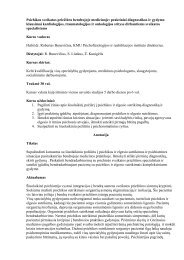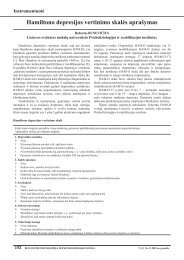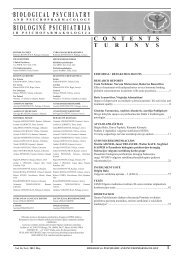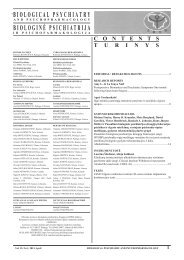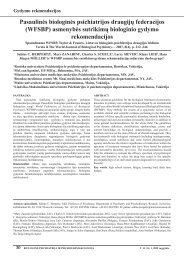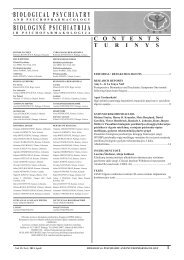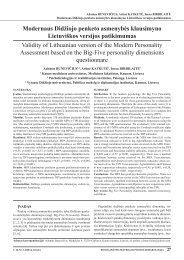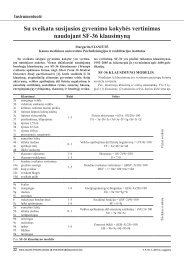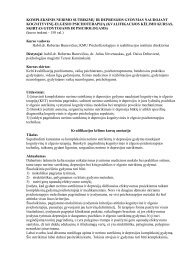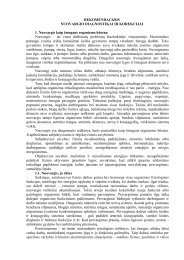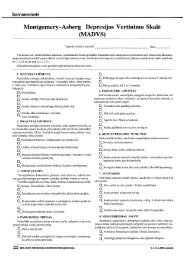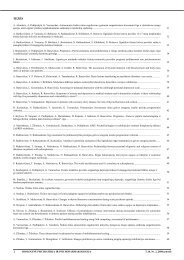biologinÄ psichiatrija - Psichofiziologijos ir reabilitacijos institutas ...
biologinÄ psichiatrija - Psichofiziologijos ir reabilitacijos institutas ...
biologinÄ psichiatrija - Psichofiziologijos ir reabilitacijos institutas ...
- No tags were found...
You also want an ePaper? Increase the reach of your titles
YUMPU automatically turns print PDFs into web optimized ePapers that Google loves.
Elmārs RancānsEnigma of Bipolar depressionScale, against placebo [22], other ratings (Montgomery-Asberg-Depression-Scale,CGI) were significantly in favour oflamotrigine. The second large RCT showed that about 52%of patients responded, which was twice that seen in the placebogroup [23]. Further, a recent RCT in patients who hadbreakthrough bipolar depression while on lithium showedthat lamotrigine add-on was significantly superior to placeboadd-on in treating depressive symptoms as indicated by significantlygreater improvements in MADRS scores [24]. Unfortunately,at present there is no controlled trial publishedcomparing lamotrigine with a standard antidepressant.Adjunctive strategiesAdjunctive lamotrigine. Although there was no previouscontrolled trial evidence for lamotrigine as an add-on tolithium or divalproex, the addition of lamotrigine was recommendedas second line option in one recent guidelines [25].This strategy is now supported by a small RCT reportingthat the addition of lamotrigine was as effective as addingan SSRI to lithium or divalproex for patients with bipolardepression [26]. A more recent larger RCT also now supportsthis strategy [24]. In the STEP-BD study, lamotrigine wasnumerically more effective than inositol or risperidone forpatients with treatment-resistant bipolar depression alreadyreceiving combination therapy with lithium, divalproex orcarbamazepine plus an antidepressant [27].Adjunctive top<strong>ir</strong>amate. A single-blind trial suggested thatadjunctive top<strong>ir</strong>amate was as effective as adjunctive bupropionwhen added to ongoing therapy with divalproex, lithiumor atypical antipsychotics [28].Adjunctive zonisamide. A chart review was conductedof naturalistic treatment with zonisamide in 35 persons withbipolar disorder taking standard mood stabilizers and otherpsychotropic agents, adjunctive zonisamide appears to havemodest benefit in global improvement [29].Adjunctive riluzole. Preliminary, open-label data suggestthat adjunctive riluzole may improve bipolar depressionwhen added to lithium therapy [30].Adjunctive pramipexole. The dopamine agonist pramipexolewas found to have good antidepressant effects in twosmall placebo controlled randomised trials in patients withbipolar depression [31, 32].Adjunctive eicosapentaenoic acid. In a 12-week RCT in85 patients with bipolar depression, adjunctive eicosapentaenoicacid (EPA) was more effective than placebo in improvingdepressive symptoms [33]. But another study did not findoverall evidence of efficacy for adjunctive treatment withEPA [34].AntidepressantsThe use of antidepresants in the treatment of bipolar depressionis a continuous area of controversies. Food and DrugAdministration (FDA) has not approved any of the more than25 standard antidepressants for the treatment of bipolar depression.However, standard antidepressants are commonlyused as adjuncts to mood-stabilizing medication for the treatmentof bipolar depression, despite limited evidence of theshort-term and long-term efficacies and the putative risk oftreatment-emergent mania or hypomania.Long-term continuation of initiated antidepressant treatmentshowed decreased the risk of depressive relapse in patientswith bipolar illness in one study [35]. In a 6-monthRCT in patients with BD II and bipolar not otherwise specifiedwho had responded to fluoxetine, relapse rates were 43%with continued fluoxetine and 100% with placebo, but thesample size was too small to show statistical significance.Although no hypomanic switch was observed, there was asignificantly greater mean increase in manic symptom scoreswith fluoxetine [36].In a placebo-controlled study in which subjects usingtherapeutic doses of the mood stabilizer lithium were randomlyassigned to receive concurrent treatment with a standardantidepressant (paroxetine or imipramine) or placebo,those receiving lithium plus an antidepressant did not havea significant advantage over those receiving lithium plusplacebo [37]. The only large positive trial of standard antidepressanttreatment for bipolar depression published todate involved the combination of olanzapine and fluoxetine,which was superior to placebo as well as to olanzapine alone[38]. However, the study did not address the effectiveness ofstandard antidepressants used in conjunction with lithium orvalproate.The recent double-blind of The Systematic Treatment EnhancementProgram for Bipolar Disorder (STEP-BD) studyequal number of patients (23,5%) receiving a mood stabilizerplus adjunctive antidepressant therapy had a durable recovery,as did 51 patients (27,3%) receiving a mood stabilizerplus a matching placebo (P=0,40) [39].The Stanley Foundation Bipolar Network study addressedcomparative efficacy of different new generation antidepresantsin the treatment of bipolar depression. Using outcomecriteria corrected for rates of treatment-emergent affectiveswitch, they reported that 33,3% of patients with bipolar depressionhad a response to treatment with bupropion, 41,4%had a response to sertraline, and 35,6% had a response tovenlafaxine, in between group differences were not statisticallysignificant [40].Treatment-emergent switch into maniaPrescription of antidepressants for bipolar patients alwayscarries certain risk of polarity switch. Some early studiesfound higher rates of treatment-emergent switch into mania inbipolar patients treated with tricyclic antidepressants (TCAs)and monoaminoxidase inhibitors (MAOs) than with selectiveserotonin re-uptake inhibitors (SSRIs) or placebo [41, 42].The double-blind comparison of bupropion, sertraline, andvenlafaxine by the Stanley Foundation Bipolar Network, oneof the largest trial in this field, found a significantly higherrate of switch from depression to mania or hypomania amongsubjects receiving venlafaxine than among those receivingbupropion or sertraline [43].Neither paroxetine nor bupropion was associated withan increased rate of treatment-emergent affective switchin STEP-BD study [39]. These results are largely in agreementwith those from studies that associate selective serotonin-reuptakeinhibitors and bupropion with lower ratesof treatment-emergent affective switch than venlafaxine orT. 10, Nr. 1, 2008 m. b<strong>ir</strong>želisBiologinė <strong>psichiatrija</strong> <strong>ir</strong> psichofarmakologija33



